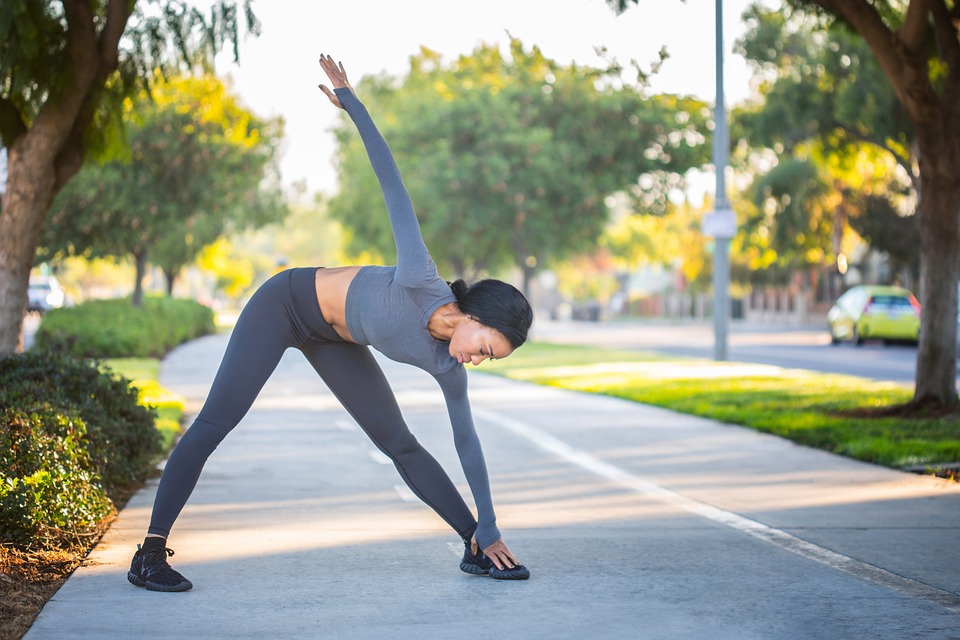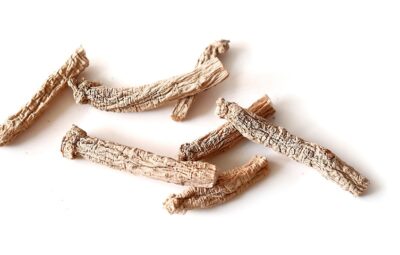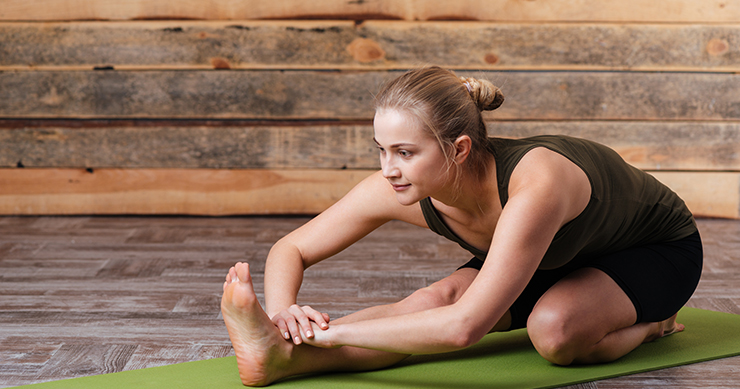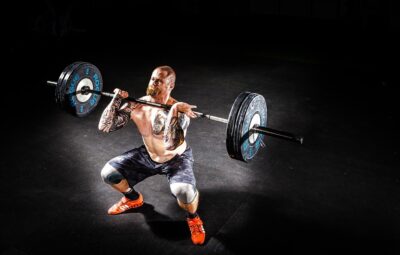If you have played any sport, you would remember that the coach would make you jog a couple of laps and stretch for the first 15-20 minutes. Do you ever wonder why they’re so adamant about it? A couple of minutes of stretching and jogging activates your muscles and warms up your body. The training you receive prepares you to meet the demands of the game. Before undertaking any strenuous activity, it is important to do some warm-up exercises and stretch to avoid injuries.
Flexibility training is important because it can help improve your range of motion, which can reduce your risk of injury. It can also help improve your posture and reduce stress.
Flexibility Training: An Introduction
The ability to stretch a muscle from one point to another is known as flexibility. Working out on a treadmill enables you to move your body across a varied range of motion in order to improve your cardiovascular fitness. Flexibility allows a person to move their joints through a range of motion without pain. Although the amount of flexibility varies widely from person to person, having a minimum range of flexibility is crucial for keeping your joints and overall body healthy.
If your muscles are not functioning properly, it can affect your movement and lead to falls and accidents. Both flexibility and balance exercises help reduce the likelihood of developing muscle imbalances. Also, they are ideal for people who are just beginning their workout routine. If you are not used to working out regularly, you may get injured without flexibility.
Flexibility training may help improve the flexibility of the hip, knee, ankles, shoulders, and spine. If you follow these instructions, it is less likely that you will hurt your back while fixing the ceiling lamp. Flexibility training does not need to be difficult to be effective. You should do some simple exercises every day to keep your joints moving.
Is the Range of Motion and Flexibility the Same?
Many individuals confuse range of motion with flexibility. A joint’s range of motion is how far it can move in any direction before it starts to hurt. Flexibility is the ability of tissues, ligaments, tendons, and muscles to extend or move through a range of motion.
If you have a good range of motion, it could improve your workouts and other activities you do every day. Stretching regularly would reduce stiffness and tightness in your joints and prevent injuries. Regular stretching activities are one approach to increasing flexibility. Although it is advisable to stretch at the beginning and end of a workout, many people don’t do it.
Stretching is also very important after sitting at a desk for a long time. Many people found that stretching was beneficial when they started working from home during the pandemic. You may be familiar with the back pain that many people developed early on in the pandemic when they were working or studying from home and sitting at their desks for long periods of time.
A muscle that is stretched well may be able to more easily reach its full range of motion. It can improve your sports performance by giving you a more flexible golf swing or tennis serve. It can also help with functional capacities such as reaching, bending, and stooping during daily duties.
A flexibility training program lasting for two months proved to have positive effects on the spine’s Range of Motions for elderly women, as seen in a study. If you are active and can stick to a routine, you may be able to reduce the stiffness in your joints that comes with age and improve your flexibility.
Flexibility Training Benefits
Improved Muscle Condition
Training your flexibility, like with stretching exercises or foam rolling, can help prevent injuries and make your muscles healthier. Foam rolling can assist in loosening stiff muscles. If you keep your muscles relaxed, you will become more flexible over time.
Stretching improves blood circulation to your muscles. It helps your muscles stay healthy by providing them with nutrients and also helps get rid of waste products. It helps you recover quickly, especially after a tough workout.
Productive Workouts
If your muscles are stiff, you won’t be able to squat down to a near parallel, which means your workouts won’t be as effective as they could be. You may only be able to do half a repetition of several exercises in your training. Doing lots of reps with light weights is not a good way to build muscle or get strong.
Your range of motion is critical if you want to bulk up, build strength, manage your weight or be healthy. Flexibility training helps your muscles move more easily and over a greater range of motion. This makes your workout worth the time and effort.
Improves Balance
It is also useful in daily life for tasks such as carrying groceries or picking something up off the ground. Maintaining good balance is important not only for activities that require it, like ballet but also for everyday tasks such as carrying groceries or picking something up off the floor. It also allows you to age gracefully. Good balance can help improve your athletic performance and focus, as well as help you age gracefully. As you age, it becomes increasingly important to stay active in order to avoid injuries and falls. If you want to improve your core strength and stability, increasing your flexibility and balance can help. If you don’t have good balance, you’re more likely to fall after tripping on something. It is important to have good balance when practicing yoga, as some asanas cannot be done without it.
Reduced Injury Risk
Flexibility training helps improve the range of motion for tendons, ligaments, and joints. Exercise not only provides numerous health benefits but also increases blood circulation to tissues, muscles, and the entire body. This means that there is less of a chance for muscle damage when the tissues around the joints are able to move.
Stretching helps your muscles to lengthen and also gets more blood flowing, which can speed up the healing process. Activity-based stretching, such as walking and reaching, may have benefits. Increasing flexibility can lead to a decrease in the time it takes to recover following an injury Stretching not only prevents injuries, but also promotes recovery. Increased flexibility can lead to shorter recovery times following an injury. The benefits of stretching stretch beyond just improving physical flexibility. A study found that stretching also increases blood flow, delays muscle soreness, and reduces stiffness while an injury is healing.
Less Stress
Muscle tension can cause much pain and anguish. A muscle that is only partially constricted can still restrict blood flow and cause pain. The build-up of lactic acid in the muscles could be causing pain in the area. Stretching regularly can help improve blood flow and reduce stress.
A research study found that a short session of stretching exercises reduced anxiety, bodily pain, and weariness for people who work. It not only increased vitality, mental wellness, general health, and flexibility but also had other benefits.
Less Pain and Body Aches
When you focus on stretching and loosening your muscles, you will likely feel better overall. Your muscles will be less tense and stiff, resulting in less joint pain and aches. If you are flexible, it is less likely that you will get muscle cramps.
What Is The Best Workout For Increasing Flexibility? Be Specific.
You will become more flexible if you stretch regularly throughout the day, especially after you exercise. Even though stretching won’t make your muscles grow, you won’t overtax your body by stretching properly.
There are seven categories under which stretching is classified:
- Ballistic stretching
- Dynamic stretching
- Active stretching
- Passive (relaxed) stretching
- Static stretching
- Isometric stretching
- PNF stretching
We will focus on passive stretching and static stretching for our goals. Passive stretching is a type of stretching where you assume a position and then hold it there using another body part or some other object. It is a relaxed stretching technique. A way to stretch your hamstring would be to prop your leg on a chair and move your body.
With static stretching, you stretch a muscle to its furthest point and hold that position for a period of time. Stretching your hamstrings, for example, could involve sitting in a chair with one leg extended straight and then reaching forward to touch your toes while maintaining that position for a duration.
Remember that “more is not better” for the following stretches. You should not push yourself to the point of pain or beyond what your body is ready for.
If you want to get the most out of your stretching, you should hold each stretch for 30 seconds without bouncing. The only feeling you should have is a slight pull in your muscles, not a feeling of being set on fire.
Chest:
Choose a weight for dumbbell flies that you could lift for 12 repetitions. Lie on a bench and lift your legs, so they are at a 90-degree angle to your body. Then, slowly lower your arms down to where your pecs will be stretched to the maximum possible. Hold this position.
Abdominals: Sit upright on the ground. Flex your knees and bring your heels together. Gently pull your feet towards your bottom. Place your elbows on the inside of your knees. Gently push your legs to the floor. Hold this position.
Shoulders (Anterior Delt):
Locate a stationary bar; a smith machine is just fine. To perform this stretching exercise, face away from the object you are trying to stretch and grab it with your palms facing downwards. Walk forward slowly until your delts are maximally stretched. Hold this position.
Shoulders (Lateral Delt):
Place a moderate amount of weight on a low pulley. Stand up and grab the low cable pulley, allowing the weight stack to stretch your side delt. If you don’t have a low pulley nearby, you can also use a wall for resistance by leaning into the wall in the stretched position.
Shoulders (Posterior Delt):
In order to perform this exercise, you must grab the elbow of one arm with the hand of the other arm, and then pull your elbow across your chest. Hold this position and repeat for the other side.
Traps:
Put a moderate amount of weight on the smith machine. Lift your shoulders up as high as possible, then lower them down as much as you can to stretch your traps. Hold this position.
Back (Lower):
Place your feet on the floor with your knees bent and your back flat on the floor. Put your hands on the back of your legs and pull your legs up toward your chest. Pull until a gentle stretch is felt. Hold this position.
Back (Middle):
Get down on your hands and knees on the floor. Curl your back up toward the ceiling. Hold this position. Return to starting position. By hollowing out your back and pulling your stomach down to the floor, you will be able to achieve a better stretch. Hold this position.
Back (Lats):
Start by hanging from a bar with your palms facing away from your in a pullup position. Lift your body up then back down. Once you are in the down position, hold onto the bar for 30 seconds. If you don’t have a pullup bar or are unable to perform this exercise, simply stretching and holding your arms as high as possible is also a great lat stretching exercise.
Biceps:
Position a bench at a 60-degree angle like you did for the triceps. Sitting on the bench, grab a pair of dumbbells. Raise the dumbbells until your biceps are curled, and lower them slowly until you feel a stretch in your biceps. Hold this position.
Triceps:
Position a bench with about a 60-degree incline. Pick up a pair of dumbbells, sit on the bench, and lean back. Reach both arms up high, then lower the weights down to your head on either side slowly. Hold until the stretch is complete.
Forearms:
Set up a flat bench and grip a barbell with your palms facing down for the forearm flexors and facing up for the extensors. Place your arms on the bench so your wrists can dangle over the edge. Lower the weight slowly until you feel a stretch. Hold this position.
Quadriceps:
An easy one for you. Sit on the ground with your knees bent, and your feet spread apart. Place your hands on the floor behind you and lean back as far as you can. You should feel a stretch in your quadriceps. Hold this position.
Glutes:
Lie on the ground with your body extended. To do a hamstring stretch, bend one leg and slide your heel toward your bottom. Use your hands to hold your ankle and knee. Gently pull your foot to the opposite shoulder. Hold this position.
Hamstrings:
Put your leg up on a chair or bench. Bend your torso towards your leg, keeping your back straight, and try to touch your toes. Hold this position.
Calves:
Another easy one for you. Stand under a smith machine and hold on to the bar. Raise the bar until you feel a muscle contraction, then lower it until you feel the muscle stretch. Hold this position.
Routine:
Creating a routine from these exercises is simple. You do not need to take as much time to recover between stretches as you do for muscles. When planning a stretching routine, the only thing you need to consider is the placement of the stretches in relation to your workouts. You should always stretch either before or after a workout, but never immediately before.
It is a quality that is useful to develop. Flexibility is a useful quality to develop because it can help in sports, training, and in everyday life. Although increasing flexibility through training can be challenging, it is not the same as just training for aesthetics or strength.







